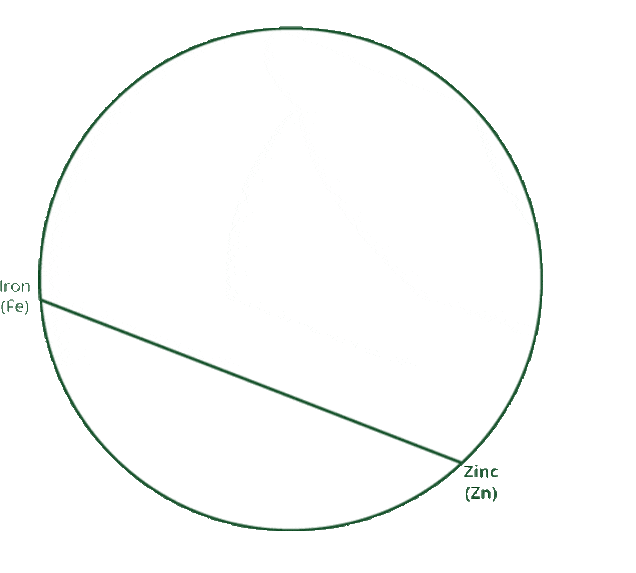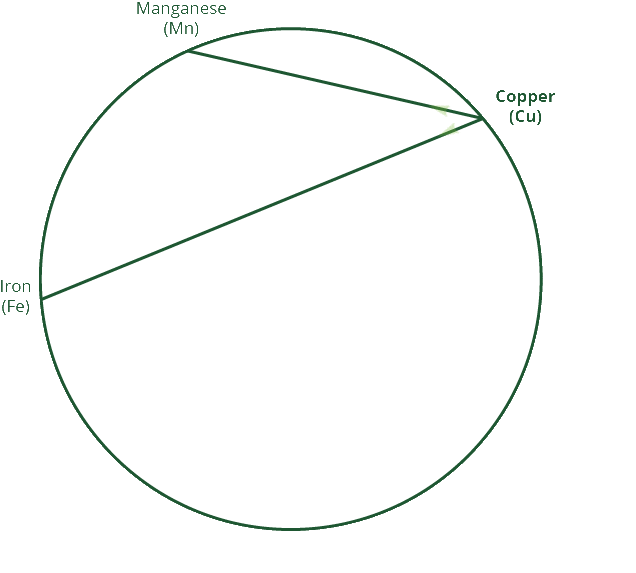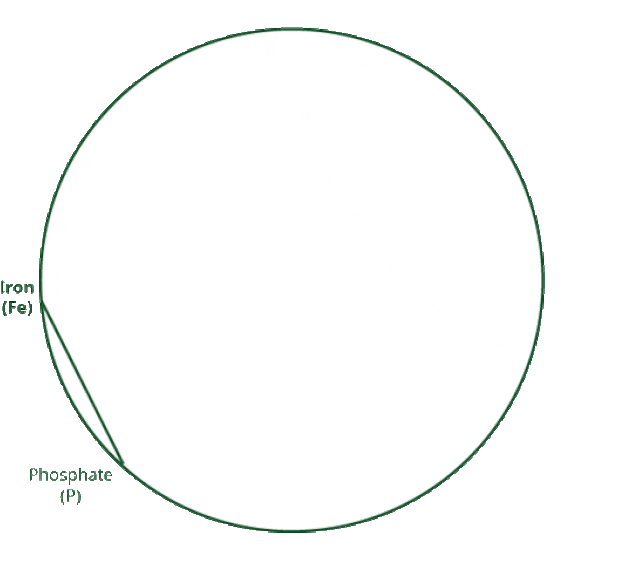Liquid Micronutrient Fertilizer Foliar Sprays: The Underrated MVP in Corn and Soybean Yield
Trying to boost corn and soybean yields with just NPK is like building a football team around one position. (Jets fans, we’re looking at you.)
While NPK forms the foundation of plant nutrition, high performing crops require more than just nitrogen, phosphorus, and potassium. Micronutrients, those trace elements often left out of the conversation , are vital to everything from energy metabolism to nitrogen fixation. Without them, you're leaving yield (and profit) on the table.
In this blog, we’ll cover why liquid micronutrient fertilizer foliar sprays deserve a bigger role in your fertility game plan, explore key elements, and explain why acetate-based formulations are often superior to sulfates or EDTA-based products.
Mulder’s Chart Illustrating Zinc’s affects on Fe
Zinc (Zn)
Function:
Essential for IAA synthesis
Supports energy metabolism
Why It Matters:
Deficiency stunts terminal growth and bud formation—key yield factors
Corn, in particular, has a high zinc demand
Limiting Factors:
High pH (>7.0), low organic matter
High phosphate inputs and glyphosate use can induce deficiency
Liquid Micronutrient Fertilizer Solution:
ZnAce – 8% Zinc Acetate Foliar Fertilizer
A highly soluble, plant-available foliar solution, ZnAce is formulated for quick uptake and efficient correction of in-season zinc deficiencies. Unlike EDTA or sulfate-based fertilizers, ZnAce leverages acetate chemistry to ensure zinc remains available without risking phytotoxicity or foliar burn.
Takeaway:
Zinc is crucial for photosynthesis in C4 crops like corn. Without it, carbohydrate production, and yield, take a hit.
Mulder’s Chart showing Copper’s affect on Mn & Fe
Copper (Cu)
Function:
Aids in respiration and nitrogen metabolism
Integral to over 100 plant proteins
Why It Matters:
Deficiency delays flowering and reduces grain, seed, and flower formation
Soybeans require copper for nodulation and nitrogen fixation
Limiting Factors:
High nitrogen applications and organic matter
Liquid Micronutrient Fertilizer Solution:
CuAce – 2% Copper Acetate Foliar Fertilizer
CuAce is a low-rate, high-efficiency copper solution designed for foliar application. Its acetate-based formulation enhances copper uptake without the phytotoxicity risks often associated with sulfate forms. Especially effective in high-N environments, CuAce supports respiration, nitrogen metabolism, and reproductive development.
Takeaway:
Copper is essential for maximizing nitrogen efficiency. Without it, applied N isn’t fully utilized and soybean nodulation suffers.
Mulder’s Chart showing Manganese’s affect on Fe
Manganese (Mn)
Function:
Supports oxidation-reduction reactions
Works with iron in chlorophyll production
Why It Matters:
Deficiency reduces grain number and yield
Increases susceptibility to root disease and freeze damage
Limiting Factors:
High OM soils, glyphosate use, and pH > 7.0
Interactions with Cu, Zn, and Fe
Liquid Micronutrient Fertilizer Solution:
MnAce – 5% Manganese Acetate Foliar Fertilizer
MnAce delivers a highly available form of manganese through an acetate base, ensuring efficient foliar absorption and minimal risk of antagonism. Ideal for addressing glyphosate-induced deficiencies, MnAce supports critical functions like chlorophyll synthesis, disease resistance, and grain development in both corn and soybeans.
Learn more about MnAce →
ZnAce+Mn – Zinc and Manganese Acetate Blend
Designed for crops that commonly require support from both zinc and manganese, this dual-action foliar provides two essential micronutrients in a single application. Ideal for corn and soybeans in high pH or glyphosate-intensive systems.
Takeaway:
With glyphosate’s widespread use, manganese deficiency is common and costly. Correcting it can protect yield potential.
Mulder’s Chart showing Boron’s affect on micronutrients to be an unknown.
Boron (B)
Function:
Carbohydrate metabolism, cell wall structure, and meristem differentiation
Key to rhizobia-legume symbiosis
Why It Matters:
Deficiency leads to poor flowering, pollination failure, and fruit shedding
Especially critical for soybeans
Limiting Factors:
Leaches easily in sandy or highly irrigated soils
Low OM soils are often deficient
Liquid Micronutrient Fertilizer Solution:
10% Boron Foliar Spray
This high-concentration boron formula is designed for rapid correction of boron deficiencies in legume and reproductive crop stages. It improves flower retention, pollination, and seed set—critical for maximizing soybean yield.
Calcium + Boron Acetate Blend
This dual-action formula delivers both calcium and boron in a foliar-ready acetate form. It strengthens cell walls, improves structural integrity, and enhances boron uptake during key reproductive windows.
Learn more about Calcium+Boron →
Takeaway:
Boron is the most important micronutrient for soybeans. Without it, flower fertility and nitrogen fixation take a big hit.
Mulder’s Chart showing Boron’s affect on N & Cu.
Molybdenum (Mo)
Function:
Critical for nitrogen utilization and nitrogen-fixing biology
Why It Matters:
Deficiency delays tasseling and reduces pollen quality in corn
Impacts nitrogen fixation in soybeans
Limiting Factors:
Low pH soils
Interference from sulfate
Liquid Micronutrient Fertilizer Solution:
Bloom 2-6-0 + Mo – Molybdenum Fertilizer
This formulation combines phosphorus and potassium with molybdenum to support nitrogen utilization, reproductive development, and early season vigor. Ideal for legumes and corn during pre-reproductive stages, it enhances nitrogen fixation and boosts pollen viability.
Mulder’s Chart showing the affects Iron has on P.
Iron (Fe)
Function:
Powers respiration, photosynthesis, and nitrogen fixation
Necessary for chlorophyll production
Why It Matters:
Deficiency suppresses photosynthesis and nitrogen fixation
Essential for both corn and soybean yields
Limiting Factors:
Poor soil aeration, waterlogging
High levels of Zn, Cu, and Mn
Liquid Micronutrient Fertilizer Solution:
FeAce – 5% Iron Acetate
FeAce delivers iron in a highly available acetate form to support photosynthesis, respiration, and nitrogen fixation. Especially effective in high pH or compacted soils where iron uptake is limited, this foliar spray helps maintain chlorophyll production and overall plant vitality.
Takeaway:
Iron is critical for both nodulation in soybeans and photosynthesis in corn. Its deficiency will limit yield in both.
Cobalt (Co)
Function:
Supports nitrogen-fixing biology in legumes
Why It Matters:
Deficiency reduces nitrogen fixation in soybeans
Limiting Factors:
High soil pH
Low organic matter
Liquid Micronutrient Fertilizer Solution: “Coming Soon!”
SoyBean Ace – Cobalt + Molybdenum Acetate Formula
SoyBean Ace is specially formulated to support legume nitrogen fixation by combining 2% cobalt acetate and 3% molybdenum (from sodium molybdate) in a foliar-ready acetate blend. Applied early at the 2 to 3 leaf stage, it enhances nodulation and nitrogen utilization to boost soybean yield potential. Use according to label directions, as excess molybdenum can affect ruminant animals.
Takeaway:
Though not officially “essential,” cobalt plays a crucial role in soybean nodulation. It’s worth considering for high-yielding legume systems.
Why We Choose Acetate-Based Liquid Micronutrient Fertilizer Sprays:
You’ll notice that our recommended foliar sprays are acetate-based. Here's why:
Better absorption: Acetates are smaller than EDTA chelates and more leaf-available
Lower risk: Sulfates can cause phytotoxicity when over-applied
Faster uptake: EDTA-bound nutrients are tightly chelated and slower for plants to access
Foliar-friendly: Acetates don’t clog leaf pores like heavier molecules
Final Thoughts: Feed the Whole Team
Relying on NPK alone is like building a football team with only quarterbacks. Sure, they're important—but without linemen, receivers, and defense, you’re not winning.
Micronutrients are the unsung heroes of crop nutrition. They drive photosynthesis, grain fill, pollination, and nitrogen fixation—everything that makes high yields possible. Most soil tests won’t tell you the full story, and many deficiencies aren’t due to absence, but inaccessibility.
That’s where liquid micronutrient fertilizer foliar sprays come in.
They bypass soil limitations, deliver key elements directly where they’re needed, and help unlock the full potential of your fertility program.
Don’t bench your yield. Feed the full team.

























